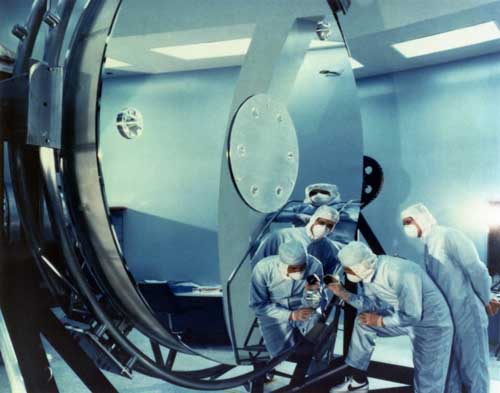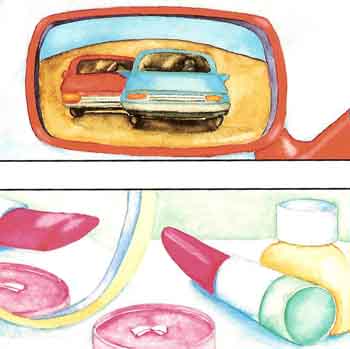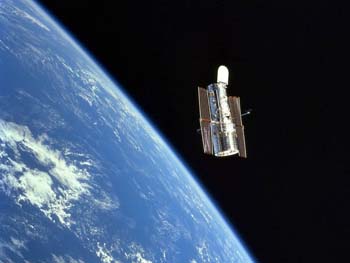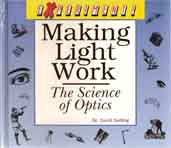MAKING LIGHT WORK: The Science of Optics - 3. In the Hall of Mirrors

Figure 1. The images of NASA technicians reflected in the curved surface of the Hubble Space Telescope's main mirror.

Figure 2. The side-view mirror of a car is a convex mirror, while a cosmetic mirror is concave.

Figure 3. The Hubble Space Telescope orbiting the Earth.
A visit to the hall of mirrors at a fair will reveal two facts. First, not all mirrors are flat. And second, curved mirrors can do very strange things to your appearance!
A mirror that curves in from the edge to the mirror is said to be CONCAVE. One that bulges out from the edge to the middle is called CONVEX (see Figure 1).

Reflections in a SpoonYou will need:
What to do:
The inside surface of the spoon acts as a concave mirror. Hold the spoon 12 inches in front of your face. Which way up is your reflection? Measure the height of the image of you head. Now replace the spoon with a flat mirror held in the same position. Measure the height of your head as seen in the flat mirror. Which image is larger? Divide the height of the image in the spoon by that in the flat mirror to find by how much your reflection has been shrunk or enlarged in the spoon. Finally, hold the spoon so that the concave side is almost touching your eye. What do you see? Which way up is the image? Is it smaller, larger, or the same as it would be in a flat mirror?
The outside surface of a spoon works as a convex mirror. Repeat all the steps just described with this side of the spoon.
Taking it further:
Hold the spoon upright in the beam tank with the concave side facing the light. Observe what happened to the beams, both from above and from the side of the tank. Tilt the spoon in different directions. How does this affect the reflected beams? Repeat these steps using the convex side of the spoon.
If you can obtain proper concave and convex mirrors, experiment with these in the beam tank. How do the results differ from those using the spoon?
The concave side of a spoon will make light rays come together. But it cannot them all meet exactly at a point. This is because the spoon is curved by different amounts in different places. The center part of the spoon is fairly flat, while parts nearer the edge curve more sharply. Because of this the focal length varies from place to place. By contrast, a specially made concave mirror has a regular curvature all over so that it can focus all incoming light rays to a point. |
Uses of Curved Mirrors
A concave mirror can produce two types of images. When an object is placed quite far from the mirror, an image is formed that is upside down and reduced in size. When the object is brought close up, however, the concave mirror gives an image that is upright and magnified. In the case of a spoon, which is highly curved, objects almost have to touch the spoon for the magnified image to appear. But a mirror that curves more gently gives an upright, magnified image at a greater distance – say, a foot or two away. This makes it useful, for example, as a shaving mirror or a makeup mirror.
Concave mirrors are also used in large telescope (see "The Hubble Space Telescope" below). They allow a lot of light to be collected from the direction in which they are pointing, so that even very faint objects can be seen.
Convex mirrors, on the other hand, give only one type of image – upright and reduced in size. Their advantage is that they can show objects spread over a wide area. This makes them useful as side-view mirrors on cars and trucks. A flat mirror would give a restricted view, but a concave mirror provides a view of most of the road behind the drive (see Figure 2).
The Hubble Space Telescope
One of the problems scientists face in trying to study the universe is that the Earth's atmosphere gets in the way. Moving currents of air and dust blur the appearance of stars and other distant objects. As a result, telescopes on the Earth's surface are limited in the amount of detail they can show.
It was a great step forward, therefore, when the Hubble Space Telescope was launched on April 24, 1990. This instrument now circles around the Earth in an orbit 373 miles high, taking the clearest pictures of the universe ever seen. The most important part of the new telescope is a concave mirror measuring 98 inches across. This gathers the light from distant objects and concentrates it onto a smaller flat mirror, ready to be magnified.
Shortly after it was launched, scientists discovered a serious error in the spacing of the two mirrors inside the Hubble Space Telescope that affected its ability to focus images. In 1993, this problem was fixed during a planned maintenance visit by astronauts.

